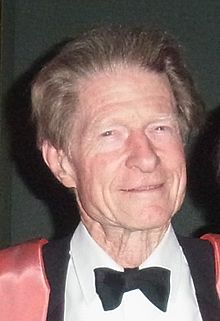John Gurdon
Sir John Bertrand Gurdon (born October 2, 1933 in Dippenhall , Hampshire , England ) is a British developmental biologist and professor emeritus at the University of Cambridge .
Gurdon explored the importance of the nucleolus of the cell. He also laid the foundation for animal cloning with his work on cell nucleus transplants . In 2012 he was awarded the Nobel Prize for Medicine together with Shin'ya Yamanaka .
Life
After graduating from Eton College , Gurdon received a BA in Zoology from Christ Church College , Oxford , in 1956 and a D.Phil in 1960 . in embryology . He subsequently stayed at Christ Church College, but had research stays at the California Institute of Technology in Pasadena and the Carnegie Institution in Baltimore . In 1983, he succeeded Alan Lloyd Hodgkin as a professor at the University of Cambridge , which he held until 1990. In 1995 he was knighted as a Knight Bachelor . From 1995 to 2002 he was a Masters at Magdalene College, Cambridge .
Gurdon has headed the Wellcome Trust / Cancer Research UK Institute at the University of Cambridge, now known as the Gurdon Institute , since 1990 . He himself continues to lead one of the 20 research groups at this institute (as of 2016).
Act
The fact that Gurdon was able to raise adult, sexually mature animals from cells to which the nucleus of different cells at different stages of maturity had been transplanted , demonstrated that the genome (with a few exceptions) does not change during the development of an individual. However, the cytoplasm contains factors that influence gene expression . He was also able to show that foreign mRNA introduced into cells is expressed .
Gurdon carried out many of his pioneering work on oocytes (= egg cells ) of clawed frogs ( Xenopus laevis ).
Awards (selection)
- 1967 Scientific Medal from the Zoological Society of London
- 1967 Albert Brachet Prize
- 1971 membership in the British Royal Society
- 1975 Feldberg Foundation Award
- 1977 Paul Ehrlich and Ludwig Darmstaedter Prize , together with Torbjörn Caspersson
- 1978 membership in the American Academy of Arts and Sciences
- 1980 membership in the National Academy of Sciences
- 1983 membership in the American Philosophical Society
- 1984 Charles-Léopold Mayer Prize
- 1984 membership in the Royal Academy of Sciences and Fine Arts of Belgium
- 1985 Royal Medal
- 1987 International Prize for Biology
- 1989 Wolf Prize in Medicine, together with Edward B. Lewis
- 1989 membership in the French Académie des Sciences
- 1991 member of the Academia Europaea
- 1995 Knighted as a Knight Bachelor with the salutation "Sir"
- 2001 Edwin G. Conklin Medal
- 2003 Copley Medal
- 2009 Rosenstiel Award , together with Irving Weissman and Shin'ya Yamanaka
- 2009 Albert Lasker Award for Basic Medical Research , together with Shin'ya Yamanaka
- 2012 Nobel Prize in Physiology or Medicine with Shin'ya Yamanaka
Fonts (selection)
- JB Gurdon: The developmental capacity of nuclei taken from intestinal epithelium cells of feeding tadpoles . In: Journal of Embryology and Experimental Morphology . tape 10 , 1962, pp. 622-640 ( [1] ).
literature
- Who's Who in America. 66th Edition, Volume 1: A – L. Marquis Who's Who, Berkeley Heights 2011, ISBN 978-0-8379-7031-8 (Volume 1), ISBN 978-0-8379-7035-6 (Complete Works ), ISSN 0083-9396 , p. 1772
Web links
- Information from the Nobel Foundation on the 2012 award ceremony for John Gurdon and Shin'ya Yamanaka
- John Gurdon at the Gurdon Institute
- List of publications (PDF; 95 kB) on the website of the Académie royale des Sciences, des Lettres et des Beaux-Arts de Belgique
Individual evidence
- ↑ Scientific Medal Winners (PDF, 108 kB) at zsl.org; accessed on April 17, 2018.
- ^ A b Académie royale des Sciences, des Lettres et des Beaux-Arts de Belgique: John Gurdon ( Memento from October 31, 2015 in the Internet Archive )
- ↑ Prizewinners 1961–1981 at feldbergfoundation.org; Retrieved December 16, 2010
- ^ Goethe University - laureate since 1952. In: uni-frankfurt.de. March 14, 2016, accessed January 23, 2016 .
- ↑ Book of Members 1780 – present, Chapter G. (PDF; 931 kB) In: American Academy of Arts and Sciences (amacad.org). Retrieved April 17, 2018 .
- ^ The Royal Medals 1950–1989 ( Memento from January 7, 2011 in the Internet Archive ) on the website of the Royal Society
- ↑ John Bertrand Gurdon (PDF; 2.7 MB) at jsps.go.jp; Retrieved December 13, 2010
- ^ The 1989 Wolf Foundation Prize in Medicine at wolffund.org.il; Retrieved December 13, 2010
- ^ John Gurdon - List des membres de l'Académie des sciences / G - Listes par ordre alphabétique - Listes des membres - Memb. In: academie-sciences.fr. Retrieved January 24, 2016 (French).
- ↑ Copley recent winners: 1990 - present day ( memento of December 1, 2010 in the Internet Archive ) at royalsociety.org; Retrieved December 13, 2010
- ^ Past Winners - Rosenstiel Award - Rosenstiel Basic Medical Sciences Research Center - Brandeis University. In: brandeis.edu. Retrieved January 23, 2016 .
- ^ Albert Lasker Basic Medical Research Award. 2009 Winners John Gurdon and Shinya Yamanaka at laskerfoundation.org; Retrieved December 12, 2010
| personal data | |
|---|---|
| SURNAME | Gurdon, John |
| ALTERNATIVE NAMES | Gurdon, John B .; Gurdon, John Bertrand |
| BRIEF DESCRIPTION | British evolutionary biologist |
| DATE OF BIRTH | October 2, 1933 |
| PLACE OF BIRTH | Dippenhall , Hampshire, England |
